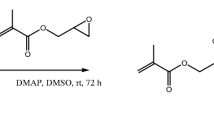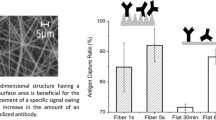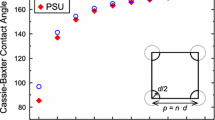Abstract
An approach is presented for covalent immobilization of biomolecules on an acrylate phosphorylcholine hydrogel. The immobilization and the hydrogel formation take place simultaneously by a thiol-acrylate coupling reaction, induced by UV-light (254 nm). The hydrogel is prepared on two polymeric surfaces (the HardCoat protective layer of Blu-Ray discs, and SU-8) and applied to fluorescence microarray and label-free interferometric detection. For the first, Cy5 labeled analytes are used (λem 635 nm) and, for the second, a periodic array of high-aspect ratio nanopillars detects unlabeled analytes by interferometry. Bioavailability of the immobilized probes is demonstrated in labeled assays; for the case of oligonucleotides by discriminating single nucleotide polymorphisms, and, for the case of antibodies, by BSA immunorecognition. The raw hydrogel is employed to detect human C-reactive protein, in both labeled and non-labeled assay formats, with sensitivities of 30 ng·mL−1 and 2 pg·mL−1, respectively.

Schematic presentation of the phosphorylcholine (MPC) hydrogel preparation onto BluRay disc and SU-8 nanopillars to perform fluorescence and label-free interferometric detection, respectively. It selectively detects C-reactive protein (CRP), but it can covalently immobilize antibodies or nucleid acid probes to detect other analytes.







Similar content being viewed by others
References
Rusmini F, Zhong Z, Feijen J (2007) Protein immobilization strategies for protein biochips. Biomacromolecules 86:1775–1789. https://doi.org/10.1021/BM061197B
Rubina AY, Dementieva EI, Stomakhin AA, Darii EL, Pan’kov SV, Barsky VE, Ivanov SM, Konovalova EV, Mirzabekov AD (2003) Hydrogel-based protein microchips: manufacturing, properties, and applications. Biotechniques 34:1008–1022. https://doi.org/10.2144/03345rr01
Vermonden T, Censi R, Hennink WE (2012) Hydrogels for Protein Delivery. Chem Rev 112:2853–2888. https://doi.org/10.1021/cr200157d
Arenkov P, Kukhtin A, Gemmell A, Voloshchuk S, Chupeeva V, Mirzabekov A (2000) Protein microchips: use for immunoassay and enzymatic reactions. Anal Biochem 278:123–131. https://doi.org/10.1006/ABIO.1999.4363
Moschallski M, Evers A, Brandstetter T, Rühe J (2013) Sensitivity of microarray based immunoassays using surface-attached hydrogels. Anal Chim Acta 781:72–79. https://doi.org/10.1016/j.aca.2013.04.013
Beyer A, Pollok S, Berg A, Weber K, Popp J (2014) Easy daylight fabricated hydrogel Array for colorimetric DNA analysis. Macromol Biosci 14:889–898. https://doi.org/10.1002/mabi.201300487
Kivlehan F, Paolucci M, Brennan D, Ragoussis I, Galvin P (2012) Three-dimensional hydrogel structures as optical sensor arrays, for the detection of specific DNA sequences. Anal Biochem 421:1–8. https://doi.org/10.1016/j.ab.2011.10.026
Herrmann A, Kaufmann L, Dey P, Haag R, Schedler U (2018) Bioorthogonal in situ hydrogels based on polyether polyols for new biosensor materials with high sensitivity. ACS Appl Mater Interfaces 10:11382–11390. https://doi.org/10.1021/acsami.8b01860
Thompson D, Pepys MB, Wood SP (1999) The physiological structure of human C-reactive protein and its complex with phosphocholine. Structure 7:169–177. https://doi.org/10.1016/S0969-2126(99)80023-9
Algarra M, Gomes D, Esteves da Silva JCG (2013) Current analytical strategies for C-reactive protein quantification in blood. Clin Chim Acta 415:1–9. https://doi.org/10.1016/j.cca.2012.09.007
Boonkaew S, Chaiyo S, Jampasa S, Rengpipat S, Siangproh W, Chailapakul O (2019) An origami paper-based electrochemical immunoassay for the C-reactive protein using a screen-printed carbon electrode modified with graphene and gold nanoparticles. Microchim Acta 186:153. https://doi.org/10.1007/s00604-019-3245-8
Byzova NA, Zherdev AV, Vengerov YY, Starovoitova ТA, Dzantiev BB (2017) A triple immunochromatographic test for simultaneous determination of cardiac troponin I, fatty acid binding protein, and C-reactive protein biomarkers. Microchim Acta 184:463–471. https://doi.org/10.1007/s00604-016-2022-1
Kim E (2013) Protein-directed immobilization of Phosphocholine ligands on a gold surface for multivalent C-reactive protein binding. Curr Top Med Chem 13:519–524
Kitayama Y, Takeuchi T (2014) Localized surface Plasmon resonance Nanosensing of C-reactive protein with poly(2-methacryloyloxyethyl phosphorylcholine)-grafted gold nanoparticles prepared by surface-initiated atom transfer radical polymerization. Anal Chem 86:5587–5594. https://doi.org/10.1021/ac501322x
Kamon Y, Kitayama Y, Itakura AN, Fukazawa K, Ishihara K, Takeuchi T (2015) Synthesis of grafted phosphorylcholine polymer layers as specific recognition ligands for C-reactive protein focused on grafting density and thickness to achieve highly sensitive detection. Phys Chem Chem Phys 17:9951–9958. https://doi.org/10.1039/C5CP00469A
Yoshimoto J, Sangsuwan A, Osaka I, Yamashita K, Iwasaki Y, Inada M, Arakawa R, Kawasaki H (2015) Optical properties of 2-Methacryloyloxyethyl Phosphorylcholine-protected au 4 nanoclusters and their fluorescence sensing of C-reactive protein. J Phys Chem C 119:14319–14325. https://doi.org/10.1021/acs.jpcc.5b03934
Matsuura R, Tawa K, Kitayama Y, Takeuchi T (2016) A plasmonic chip-based bio/chemical hybrid sensing system for the highly sensitive detection of C-reactive protein. Chem Commun 52:3883–3886. https://doi.org/10.1039/C5CC07868G
Morais S, Tortajada-Genaro L, Maquieira A (2014) Array-on-a-disk? How Blu-ray technology can be applied to molecular diagnostics. Expert Rev Mol Diagn 14:773–775. https://doi.org/10.1586/14737159.2014.929945
Holgado M, Barrios C a., Ortega FJ, et al (2010) Label-free biosensing by means of periodic lattices of high aspect ratio SU-8 nano-pillars. Biosens Bioelectron 25:2553–2558. doi: https://doi.org/10.1016/j.bios.2010.04.042
Sanza FJ, Holgado M, Ortega FJ, Casquel R, López-Romero D, Bañuls MJ, Laguna MF, Barrios CA, Puchades R, Maquieira A (2011) Bio-photonic sensing cells over transparent substrates for anti-gestrinone antibodies biosensing. Biosens Bioelectron 26:4842–4847. https://doi.org/10.1016/j.bios.2011.06.010
Lavín Á, Casquel R, Sanza FJ, Laguna MF, Holgado M (2013) Efficient design and optimization of bio-photonic sensing cells (BICELLs) for label free biosensing. Sensors Actuators B Chem 176:753–760. https://doi.org/10.1016/j.snb.2012.09.058
Mira D, Llorente R, Morais S, et al (2004) <title>High-throughput screening of surface-enhanced fluorescence on industrial standard digital recording media</title> In: Carrano JC, Zukauskas A (eds). International Society for Optics and Photonics, pp 364–373
Alonso R, Jiménez-Meneses P, García-Rupérez J, Bañuls MJ, Maquieira Á (2018) Thiol–ene click chemistry towards easy microarraying of half-antibodies. Chem Commun 54:6144–6147. https://doi.org/10.1039/C8CC01369A
Chen H, Huang J, Lee J, Hwang S, Koh K (2010) Surface plasmon resonance spectroscopic characterization of antibody orientation and activity on the calixarene monolayer. Sensors Actuators B Chem 147:548–553. https://doi.org/10.1016/J.SNB.2010.03.033
Bañuls M-J, Jiménez-Meneses P, Meyer A, Vasseur JJ, Morvan F, Escorihuela J, Puchades R, Maquieira Á (2017) Improved performance of DNA microarray multiplex hybridization using probes anchored at several points by thiol–Ene or thiol–Yne coupling chemistry. Bioconjug Chem 28:496–506. https://doi.org/10.1021/acs.bioconjchem.6b00624
Jiménez-Meneses P, Bañuls M-J, Puchades R, Maquieira Á (2018) Fluor-thiol Photocoupling reaction for developing high performance nucleic acid (NA) microarrays. Anal Chem 90:11224–11231. https://doi.org/10.1021/acs.analchem.8b00265
Escorihuela J, Bañuls M-J, Puchades R, Maquieira Á (2014) Site-specific immobilization of DNA on silicon surfaces by using the thiol–yne reaction. J Mater Chem B 2:8510–8517. https://doi.org/10.1039/C4TB01108B
Escorihuela J, Bañuls MJ, Grijalvo S, Eritja R, Puchades R, Maquieira Á (2014) Direct covalent attachment of DNA microarrays by rapid thiol-ene “click” chemistry. Bioconjug Chem 25:618–627
González-Lucas D, Bañuls M-J, Puchades R, Maquieira Á (2016) Versatile and easy fabrication of advanced surfaces for high performance DNA microarrays. Adv Mater Interfaces 3:1500850. https://doi.org/10.1002/admi.201500850
Lee JH, Yoon KH, Hwang KS, Park J, Ahn S, Kim TS (2004) Label free novel electrical detection using micromachined PZT monolithic thin film cantilever for the detection of C-reactive protein. Biosens Bioelectron 20:269–275. https://doi.org/10.1016/j.bios.2004.01.024
Roberts WL, Moulton L, Law TC, Farrow G, Cooper-Anderson M, Savory J, Rifai N (2001) Evaluation of nine automated high-sensitivity C-reactive protein methods: implications for clinical and epidemiological applications. Part 2. Clin Chem 47:418–425
Hu WP, Hsu H-Y, Chiou A, Tseng KY, Lin HY, Chang GL, Chen SJ (2006) Immunodetection of pentamer and modified C-reactive protein using surface plasmon resonance biosensing. Biosens Bioelectron 21:1631–1637. https://doi.org/10.1016/j.bios.2005.11.001
Kim H-C, Lee S-K, Sohn Y-S, Ryu HK, Jeong SW (2007) Preparation of a sensing membrane for C-reactive protein. Macromol Symp 249–250:71–75. https://doi.org/10.1002/masy.200750312
Yuk JS, Jung J-W, Hyun J, Kim YM, Ha KS (2008) Development of a scanning surface plasmon microscope based on white light for analysis of a wide range of protein arrays. Sensors Actuators B Chem 131:241–246. https://doi.org/10.1016/j.snb.2007.11.019
Vashist SK, Schneider EM, Luong JHT (2015) Surface plasmon resonance-based immunoassay for human C-reactive protein. Analyst 140:4445–4452. https://doi.org/10.1039/C5AN00690B
Acknowledgements
This research was funded by FEDER and the MINECO projects CTQ/2016/75749-R and TEC/2017/84846-R. The authors acknowledge the contribution of the Bc’s D students Alejandra Vargas and Ismael Guerrero for the time spent at our lab and for their enthusiastic ideas on the possibilities of MPC hydrogel.
Author information
Authors and Affiliations
Corresponding author
Ethics declarations
The author(s) declare that they have no competing interests.
Additional information
Publisher’s note
Springer Nature remains neutral with regard to jurisdictional claims in published maps and institutional affiliations.
Electronic supplementary material
Rights and permissions
About this article
Cite this article
Díaz-Betancor, Z., Bañuls, MJ., Sanza, F.J. et al. Phosphorylcholine-based hydrogel for immobilization of biomolecules. Application to fluorometric microarrays for use in hybridization assays and immunoassays, and nanophotonic biosensing. Microchim Acta 186, 570 (2019). https://doi.org/10.1007/s00604-019-3691-3
Received:
Accepted:
Published:
DOI: https://doi.org/10.1007/s00604-019-3691-3




